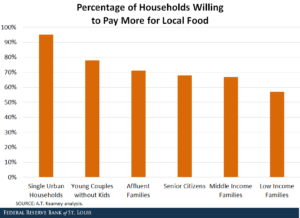Andrew Dumont indicated in an update posted yesterday at On The Economy Blog (Federal Reserve Bank of St. Louis) that, “The demand for regional food—or food produced in the same region in which it is consumed—has been on the rise. For example, direct-to-consumer sales of regional food has risen from $0.4 billion in 1992 to $1.3 billion in 2012. What is driving the increase, and what are some potential economic impacts of such an increase?”
The update indicated that, “A publication recently released by the Federal Reserve Bank of St. Louis and the Federal Reserve Board, Harvesting Opportunity: The Power of Regional Food System Investments to Transform Communities, explored the rapid growth of regional food systems and their potential economic impacts in communities throughout the nation.
“Among its findings was that consumer demand may be driving the recent growth in the regional food industry. One analysis found that a majority of consumers across the income spectrum are willing to pay more for locally sourced foods, as shown in the figure below.”

“The Economic Impact of Locally Produced Food,” by Andrew Dumont. On The Economy Blog- Federal Reserve Bank of St. Louis (December 5, 2017).
The St. Louis Fed update pointed out that, “The demand for local food has helped support an industry that had been in decline, with the number of small farms ever decreasing and the median age of farmers continually rising.
“Studies have shown that the financial impacts of selling into regional markets are greater for fruit and vegetable farms with gross annual revenue under $350,000. Farms of that size that sell in regional markets are shown to be more likely to earn positive net farm income and have lower operating expense ratios, resulting in increased farm viability.”

